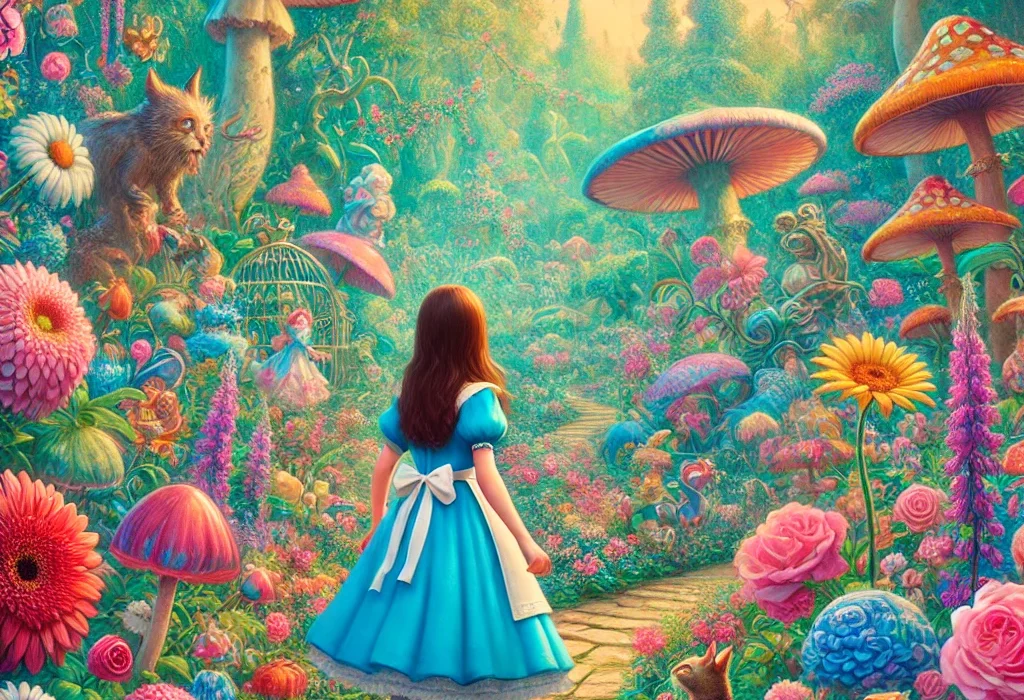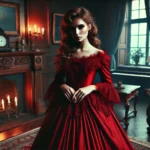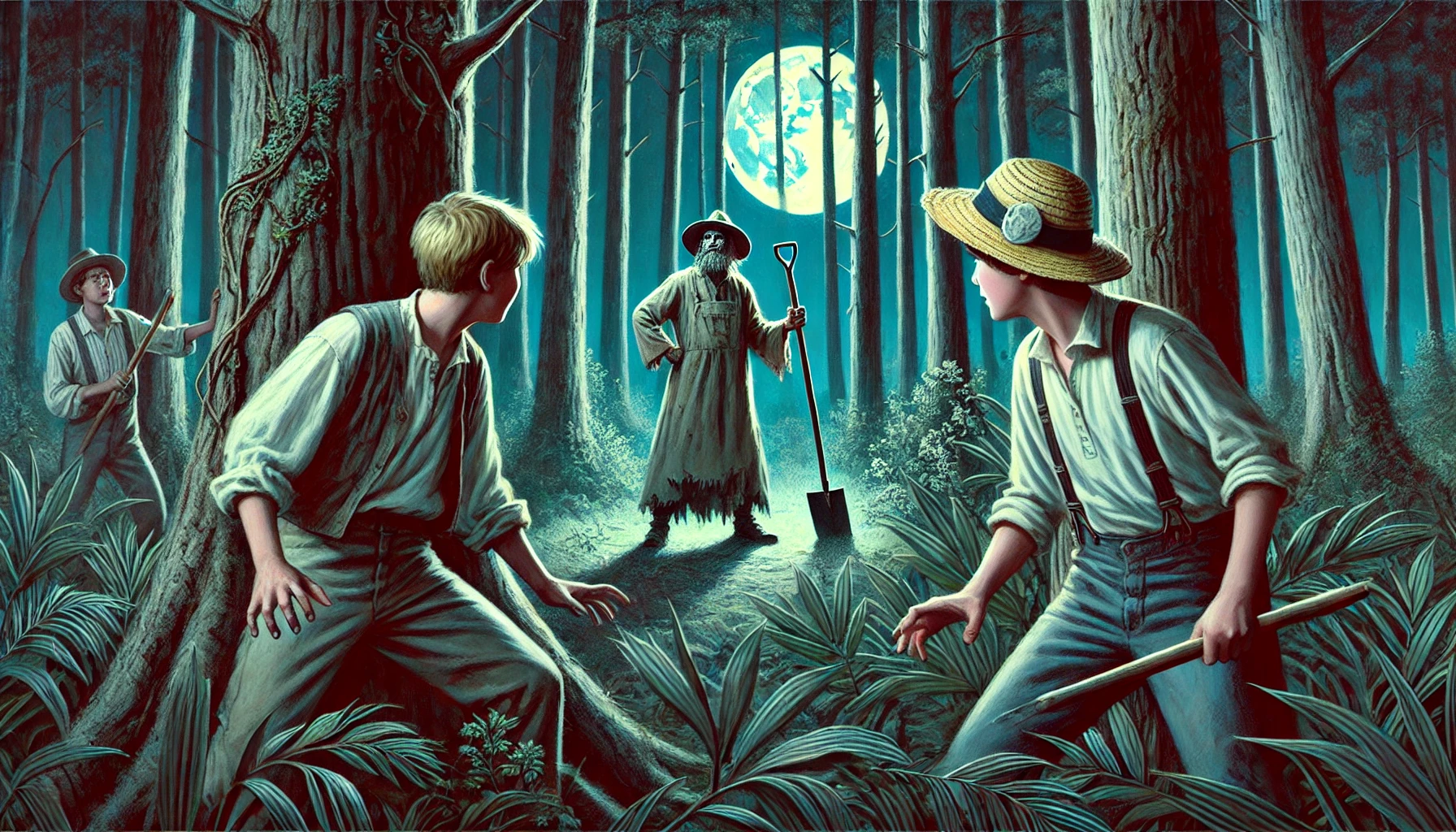“Alice’s Adventures in Wonderland” is a whimsical fantasy novel by Lewis Carroll, originally published in 1865. It follows the journey of a young girl named Alice as she falls down a rabbit hole into a strange and surreal world filled with eccentric characters, peculiar creatures, and nonsensical adventures. Written during the Victorian era, Carroll’s work is known for its playful language, dreamlike atmosphere, and its departure from the structured morality tales typical of children’s literature at the time.
Plot Summary
Alice sat beside her sister on a warm, lazy afternoon, feeling bored and listless. The book her sister read had no pictures or conversations, and Alice thought, “What is the use of a book without pictures or conversations?” As she pondered this, a peculiar White Rabbit with pink eyes rushed by, muttering about being late. What truly surprised Alice was that the rabbit pulled a pocket watch from its waistcoat. Burning with curiosity, Alice jumped to her feet and followed the rabbit down a rabbit hole, not thinking of how she would get out again.
The rabbit hole was deeper than Alice expected, and she fell for what seemed like miles, passing cupboards and shelves. Finally, she landed softly in a hallway filled with locked doors. On a glass table, Alice found a small key and a bottle labeled “DRINK ME.” After drinking from the bottle, she shrank to the size of a doll, perfect for fitting through a tiny door leading to a beautiful garden—but she realized she had left the key on the table far above her.
Not one to give up easily, Alice found a cake labeled “EAT ME” and ate it, hoping it would solve her problem. But instead of shrinking further, she grew to an enormous size, filling the entire hall. Desperate and tearful, Alice caused a flood of her own tears, which filled the hall and carried her away like a river when she finally shrank again after picking up the fan the White Rabbit had dropped.
As Alice swam in the pool of her tears, she encountered an assortment of animals, including a mouse and several birds, who joined her in trying to dry off. The animals held a nonsensical Caucus Race, where everyone ran in circles until they were dry, and at the end, all declared themselves winners. Alice, much amused, was nevertheless longing to escape Wonderland’s strange logic and make sense of what was happening.
Alice’s adventure deepened when she encountered the grinning Cheshire Cat, who appeared and disappeared at will. The cat gave Alice cryptic advice, directing her to visit the Mad Hatter and the March Hare. She found them hosting a never-ending tea party. The Hatter, the Hare, and a sleepy Dormouse babbled riddles and nonsensical stories. Despite the utter chaos, Alice stayed, bewildered by the absurdity of the tea party’s rules, where time had apparently stopped altogether.
After leaving the tea party, Alice found herself at the Queen of Hearts’ croquet ground. The Queen, a tyrannical figure, ruled Wonderland with a shout of “Off with their heads!” at the slightest offense. She was a volatile ruler, commanding the oddest croquet match Alice had ever seen, where the balls were live hedgehogs, the mallets were flamingos, and the soldiers serving as arches bent over in fear. The game was chaotic, much like everything else in Wonderland, but the Queen’s constant threat of execution made it all the more unnerving.
The Cheshire Cat reappeared during the game, only his head visible, much to the Queen’s frustration. This led to a heated argument between the Queen and the King of Hearts over whether one could decapitate a head without a body. Alice, now entangled in Wonderland’s bizarre legal proceedings, was called as a witness in the trial of the Knave of Hearts, who was accused of stealing the Queen’s tarts.
The trial was as absurd as the rest of Alice’s adventures, with witnesses like the Mad Hatter and the Duchess’s cook giving nonsensical testimonies. The Queen, determined to have the Knave executed regardless of the evidence, became increasingly enraged. When Alice grew back to her full size in the courtroom, her courage grew as well. She finally confronted the Queen, declaring that the trial and the inhabitants of Wonderland were “nothing but a pack of cards.”
As Alice stood defiant, the cards flew up into the air, whirling around her in a frenzy. In the chaos, Alice felt a sharp tug, and suddenly, she was back on the riverbank, waking up from what seemed like a strange, wondrous dream. Her sister was still reading quietly beside her, and Alice realized that her adventure in Wonderland had been a fantastical dream, yet it lingered in her mind like a curious echo. She pondered the odd characters she had met, their strange behaviors, and the bizarre logic of Wonderland, marveling at the dreamworld’s vividness.
Though her adventure was over, Alice couldn’t shake the sense of wonder and curiosity that had drawn her into the rabbit hole. She rose from the grass, thinking of the many adventures that still awaited her, for the world, even without talking rabbits and grinning cats, was full of mysteries yet to be explored. Wonderland, she knew, would remain with her, not just as a dream, but as a reminder of the endless possibilities that curiosity could unlock.
Main Characters
Alice: The protagonist, Alice is a curious and adventurous young girl whose thirst for exploration leads her into Wonderland. Throughout the story, she questions the bizarre logic of the world she enters while trying to make sense of the rules governing it. Her interactions with the Wonderland characters reflect her growing maturity, though she retains a childlike perspective.
The White Rabbit: A frantic, anxious creature, the White Rabbit leads Alice down the rabbit hole. He is constantly fretting about being late for an unspecified engagement with the Duchess, and his nervous energy propels Alice deeper into Wonderland’s absurdities.
The Cheshire Cat: This grinning feline is known for its cryptic advice and ability to appear and disappear at will. The Cheshire Cat’s philosophical demeanor and cryptic statements guide Alice, albeit in a perplexing way, through her journey.
The Mad Hatter: A nonsensical figure who presides over a never-ending tea party, the Mad Hatter is eccentric and unpredictable. He epitomizes the chaotic logic of Wonderland, embodying the arbitrary rules of time and etiquette.
The Queen of Hearts: A hot-tempered, authoritative figure who rules Wonderland with a harsh and capricious hand. Her signature catchphrase, “Off with their heads!” reveals her quick temper and tyrannical tendencies. Despite her threats, she is more bluster than action, as most of her sentences are not carried out.
Theme
Absurdity and Nonsense: The novel thrives on its absurdity, with much of its humor stemming from the breakdown of logic. Carroll uses nonsense to challenge expectations, as seen in Alice’s conversations with Wonderland’s inhabitants, where words and meanings often shift in unpredictable ways.
Curiosity and Exploration: Alice’s journey into Wonderland begins with her curiosity about the White Rabbit. Her inquisitive nature drives the narrative forward, and her exploration of Wonderland symbolizes the adventurous spirit of childhood and the thirst for knowledge.
Identity and Growth: Throughout the story, Alice grapples with her sense of identity. Her frequent changes in size and the strange behaviors of Wonderland’s inhabitants lead her to question who she really is. This reflects the process of growing up and the confusion that often accompanies personal transformation.
The Nature of Authority: The Queen of Hearts and other authority figures in Wonderland are shown to be absurd and arbitrary. Through exaggerated characters like the Queen, Carroll critiques the rigid structures of power and authority in Victorian society.
Writing Style and Tone
Lewis Carroll’s writing style in Alice’s Adventures in Wonderland is marked by his inventive use of language and playful tone. His mastery of wordplay, riddles, and puns infuses the story with a sense of whimsy and unpredictability. He often subverts logic to create a world where the nonsensical becomes the norm, yet his narrative retains a sense of coherence through Alice’s perspective. The dialogue between characters is sharp, often reflecting the confusion Alice feels, yet it is rich in humor and wit.
The tone of the novel fluctuates between lighthearted and whimsical to occasionally dark and unsettling. Although much of the book is written with a playful, almost surreal touch, there are moments where the arbitrary violence (such as the Queen’s constant demands for executions) and Alice’s frustration give the story an edge. Carroll balances these tonal shifts skillfully, allowing the story to appeal to both children and adults by layering its seemingly simple narrative with deeper reflections on the nature of reality and growing up.
We hope this summary has sparked your interest and would appreciate you following Celsius 233 on social media:
There’s a treasure trove of other fascinating book summaries waiting for you. Check out our collection of stories that inspire, thrill, and provoke thought, just like this one by checking out the Book Shelf or the Library
Remember, while our summaries capture the essence, they can never replace the full experience of reading the book. If this summary intrigued you, consider diving into the complete story – buy the book and immerse yourself in the author’s original work.
If you want to request a book summary, click here.
When Saurabh is not working/watching football/reading books/traveling, you can reach him via Twitter/X, LinkedIn, or Threads
Restart reading!








